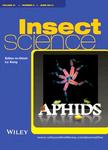Changes in free amino acids and polyamine levels in Satsuma leaves in response to Asian citrus psyllid infestation and water stress
Changes in free amino acids and polyamine levels in Satsuma leaves in response to Asian citrus psyllid infestation and water stress作者机构:USDA-ARS ERRC 600 E Mermaid lane Wyndmoor PA 19038-8598 USDA-ARS SPARC 2881 F&B Road College Station TX 77845 Texas A&M University-Kingsville Citrus Center 312 North International Blvd Weslaeo TX 78596 U. S. Horticultural Research Laboratory 2001 South Rock Road Fort Pierce FL 34945 Subtropical Horticultural Research Station 13601 Old Coulter Road Miami FL 33158 USDA-ARS 2413 E. Hwy 83 Weslaco TX 78596 USA
出 版 物:《Insect Science》 (昆虫科学(英文版))
年 卷 期:2014年第21卷第6期
页 面:707-716页
核心收录:
学科分类:0710[理学-生物学] 0830[工学-环境科学与工程(可授工学、理学、农学学位)] 09[农学] 0904[农学-植物保护] 0901[农学-作物学] 0713[理学-生态学]
主 题:amino acids citrus Diaphorina citri polyamines
摘 要:The effects of biotic and abiotic stresses on changes in amino acids and polyamine levels in Satsuma orange (Citrus unshiu; cultivar Owari) leaves were inves- tigated. Asian citrus psyllids Diaphorina citri (Kuwayama) (ACP) infestation was used to induce biotic stress while a water deficit was imposed to induce abiotic stress. Potted trees were infested by placing 50 psyllids on 3 citrus leaves enclosed in nylon mesh bags for 5 d. A parallel set of plants were kept water stressed by maintaining the soil at 20% water holding capacity for 5 d. Levels of total free amino acids were higher in water stressed and ACP infested leaves. Polyamine putrescine increased in infested leaves but not in water stressed leaves. Proline was the most abundant amino acid and its levels significantly increased by both biotic and abiotic stresses. Proline levels in infested leaves were significantly higher than the water stressed leaves. Histidine, methionine, asparagine, arginine, serine, and leucine levels also increased significantly in infested leaves, but in water stressed leaves only leucine, methionine, and threonine increased. Levels of amino acids, such as tyrosine, isoleucine, phenylalanine, glutamic acid, and alanine, declined in infested leaves. Under water stress asparagine, phenylalanine, serine, and histidine also declined compared to controls. This indicates that while proteolysis occurred under both stresses, metabolic conversion of amino acids was different under the two stresses. In ACP infested leaves some amino acids may be used as feeding material and/or converted into secondary metabolites for defense.



